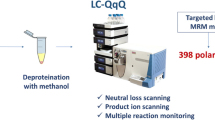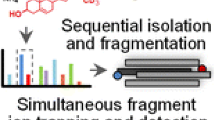Abstract
Phytosterol oxidation products (POPs) have been suggested to exert adverse biological effects similar to, although less severe than, their cholesterol counterparts. For that reason, their analysis in human plasma is highly relevant. Comprehensive two-dimensional gas chromatography (GC×GC) coupled with time-of-flight mass spectrometry (TOF-MS) has been proven to be an extremely powerful separation technique for the analysis of very low levels of target compounds in complex mixtures including human plasma. Thus, a GC×GC/TOF-MS method was developed and successfully validated for the simultaneous quantification of ten POPs in human plasma. The calibration curves for each compound showed correlation coefficients (R 2) better than 0.99. The detection limits were below 0.1 ng mL−1. The recovery data were between 71.0% and 98.6% (RSDs <10% for all compounds validated). Good results were obtained for within- and between-day repeatability, with most values being below 10%. In addition, non-targeted sterol metabolites were also identified with the method. The concentrations of POPs found in human plasma in the current study are between 0.3 and 4.5 ng mL−1, i.e., 10–100 times lower than the typical values found for cholesterol oxidation products.

Extracted regions of GC×GC/TOF-MS chromatograms displaying derivatives of sterol oxidation products and sterols for plasma samples



Similar content being viewed by others
References
Katan MB, Grundy SM, Jones P, Law M, Miettinen T, Paoletti R (2003) Efficacy and safety of plant stanols and sterols in the management of blood cholesterol levels. Mayo Clin Proc 78:965–978
Berger A, Jones PJH, Abumweis SS (2004) Plant sterols: factors affecting their efficacy and safety as functional food ingredients. Lipids Health Dis 3:5
Demonty I, Ras RT, van der Knaap HC, Duchateau GS, Meijer L, Zock PL, Geleijnse JM, Trautwein EA (2009) Continuous dose–response relationship of the LDL-cholesterol-lowering effect of phytosterol intake. J Nutr 139(2):271–284
Cercaci L, Rodríguez-Estrada MT, Lercker G, Decker EA (2006) Phytosterol oxidation in oil-in-water emulsions and bulk oil. Food Chem 102:161–167
Zhang X, Julien-David D, Miesch M, Raul F, Geoffroy P, Aoude-Werner D, Ennhanar S, Marchioni E (2006) Quantitative analysis of β-sitosterol oxides induced in vegetable oils by natural sunlight, artificially generated light and irradiation. J Agric Food Chem 54:5410–5415
Schroepfer GJ Jr (2000) Oxysterols: modulators of cholesterol metabolism and others processes. Phys Rev 80:361–554
Leonarduzzi G, Sottero B, Poli G (2002) Oxidized products of cholesterol: dietary and metabolic origin and proatherosclerotic effects (review). J Nutr Biochem 13:700–710
Lordan S, Mackrill JJ, O’Brien NM (2009) Oxysterols and mechanisms of apoptotic signalling: implications in the pathologies of degenerative diseases. J Nutr Biochem 20:321–336
Roussi S, Winter A, Gossé F, Werner D, Zhang X, Marchioni E, Geoffrroy P, Miesch M, Raul F (2005) Different apoptotic mechanisms are involved in the antiproliferative effects of 7β-hydroxysitosterol and 7β-hydroxycholesterol in human colon cancer cells. Cell Death Diff 12:128–135
Abramsson-Zetterberg L, Svensson M, Johnsson L (2007) No evidence of genotoxic effect in vivo of phytosterol oxidation products triols and epoxide. Toxicol Lett 173:132–139
Grandgirard A, Sergiel JP, Nour M, Demaison-Meloche J, Giniès C (1999) Lymphatic absorption of phytosterol oxides in rats. Lipids 34(6):563–569
Tomoyori H, Kawata Y, Higuchi T, Ichi I, Sato H, Sato M, Ikeda I, Imaizumi K (2004) Phytosterol oxidation products are absorbed in the intestinal lymphatics in rats but do not accelerate atherosclerosis in apoliprotein E-deficient mice. J Nutr (Biochem Mol Actions Nutr) 34:1690–1696
Hovenkamp E, Demonty I, Plat J, Lütjohann D, Mensink RP, Trautwein EA (2008) Biological effects of oxidized phytosterols: a review of the current knowledge. Prog Lipid Res 47:37–49
Grandgirard A, Martine L, Demaison L, Cordelet C, Joffre C, Berdeaux O, Semon E (2004) Oxyphytosterols are present in plasma of healthy human subjects. Br J Nutr 91:101–106
Menéndez-Carreño M, García-Herreros AI, Ansorena D (2008) Validation of a gas chromatography–mass spectrometry method for the simultaneous analysis of cholesterol and phytosterol oxidation products in serum. J Chromatogr B 864:61–68
Husche C, Weigärtner O, Petterson H, Vanmierlo T, Böhm M, Laufs U, Lütjohann D (2011) Validation of an isotope dilution gas chromatography–mass spectrometry method for analysis of 7-oxygenated campesterol and sitosterol in human serum. Chem Phys Lipids 164:425–431
Guardiola F, Bou R, Boatella J, Codony R (2004) Analysis of sterol oxidation products in foods. J AOAC Int 87:441–466
Kemmo S, Soupas L, Lampi AM, Piironen V (2005) Formation and decomposition of stigmasterol hydroxyperoxides and secondary oxidation products during thermo-oxidation. Eur J Lipid Sci Tech 107:805–814
Griffiths WJ, Wang Y (2009) Analysis of neurosterols by GC-MS and LC-MS/MS. J Chromatogr B 877(26):2778–2805
Janssen HG, Steenbergen H, de Koning S (2009) The role of comprehensive chromatography in the characterization of edible oils and fats. Eur J Lipid Sci Tech 111:1171–1184
Ryan D, Morrison P, Marriott P (2005) Orthogonality considerations in comprehensive two-dimensional gas chromatography. J Chromatogr A 1071(1–2):47–53
Dallüge J, van Rijn M, Beens J, Vreuls RJJ, Brinkman UATh (2002) Comprehensive two-dimensional gas chromatography with time-of-flight mass spectrometric detection applied to the determination of pesticides in food extracts. J Chromatogr A 965(1–2):207–217
Mitrevski BS, Brenna JT, Zhang Y, Marriott PJ (2008) Application of comprehensive two-dimensional gas chromatography to sterols analysis. J Chromatogr A 1214(1–2):134–142
Mitrevski BS, Wilairat P, Marriott PJ (2009) Evaluation of World Anti-Doping Agency criteria for anabolic agent analysis by using comprehensive two-dimensional gas chromatography–mass spectrometry. Anal Bioanal Chem 396(7):2503–2511
Lankinen M, Schwab U, Seppanen-Laakso T, Ismo M, Juntunen K, Mykkanen H, Poutanen K, Gylling H, Oresic M (2011) Metabolomic analysis of plasma metabolites that may mediate effects of rye bread on satiety and weight maintenance in postmenopausal women. J Nutr 141:31–36
Louter AJ (2004) Determination of plant sterol oxidation products in plant sterol enriched spreads, fat blends and plant sterol concentrates. J AOAC Int 87(2):485–492
Guardiola F, Codony R, Rafecas M, Boatella J (1995) Comparison of three methods for the determination of oxysterols in spray-dried egg. J Chromatogr A 705:289–304
ICH Harmonised tripartite guideline. Validation of analytical procedures: text and methodology Q2 (R1) (1996). International Conference on Harmonisation of Technical Requirements for Registration of Pharmaceuticals for Human Use
Mitrevski BJ, Wilairat P, Marriott PJ (2010) Comprehensive two-dimensional gas chromatography improves separation and identification of anabolic agents in doping control. J Chromatogr A 1217:127–135
Aringer L, Eneroth P, Nordström L (1976) Side-chain hydroxylation of cholesterol, campesterol and beta-sitosterol in rat-liver mitochondria. J Lipid Res 17:263–272
Brown AJ, Jessup W (2009) Oxysterols: sources, cellular storage and metabolism, and new insights into their roles in cholesterol homeostasis. Mol Aspects Med 30(3):111–122
Kallio M, Hyötyläinen T (2010) Simple calibration procedure for comprehensive two-dimensional gas chromatography. J Chromatogr A 1200(2):264–267
Laitinen T, Herrero Martín S, Parshintsev J, Hyötyläinen T, Hartonen K, Riekkola M-L, Kulmala M, Pérez Pavón JL (2010) Determination of organic compounds from wood combustion aerosol nanoparticles by different gas chromatographic systems and by aerosol mass spectrometry. J Chromatogr A 1217(1):151–159
Kumar BS, Chung BC, Lee YJ, Yi HJ, Byung Lee BH, Jung BH (2010) Gas chromatography–mass spectrometry-based simultaneous quantitative analytical method for urinary oxysterols and bile acids in rats. J Steroid Biochem Mol Biol 121(3–5):556–564
Razzazi-Fazeli E, Kleineisen S, Luf W (2000) Determination of cholesterol oxides in processed food using high-performance liquid chromatography–mass spectrometry with atmospheric pressure chemical ionisation. J Chromatogr A 896:321–334
DeBarber AE, Lütjohann D, Merkens L, Steiner RD (2008) Liquid chromatography–tandem mass spectrometry determination of plasma 24S-hydroxycholesterol with chromatographic separation of 25-hydroxycholesterol. Anal Biochem 381(1):151–153
Honda A, Miyazaki T, Ikegami T, Iwamoto J, Yamashita K, Numazawa M, Matsuzaki Y (2010) Highly sensitive and specific analysis of sterol profiles in biological samples by HPLC-ESI-MS/MS. J Chromatogr A 1217(1):151–159
Author information
Authors and Affiliations
Corresponding author
Additional information
Published in the special issue Comprehensive Multidimensional Separations with Guest Editors James Harynuk and Philip Marriott.
Rights and permissions
About this article
Cite this article
Menéndez-Carreño, M., Steenbergen, H. & Janssen, HG. Development and validation of a comprehensive two-dimensional gas chromatography–mass spectrometry method for the analysis of phytosterol oxidation products in human plasma. Anal Bioanal Chem 402, 2023–2032 (2012). https://doi.org/10.1007/s00216-011-5432-2
Received:
Revised:
Accepted:
Published:
Issue Date:
DOI: https://doi.org/10.1007/s00216-011-5432-2




